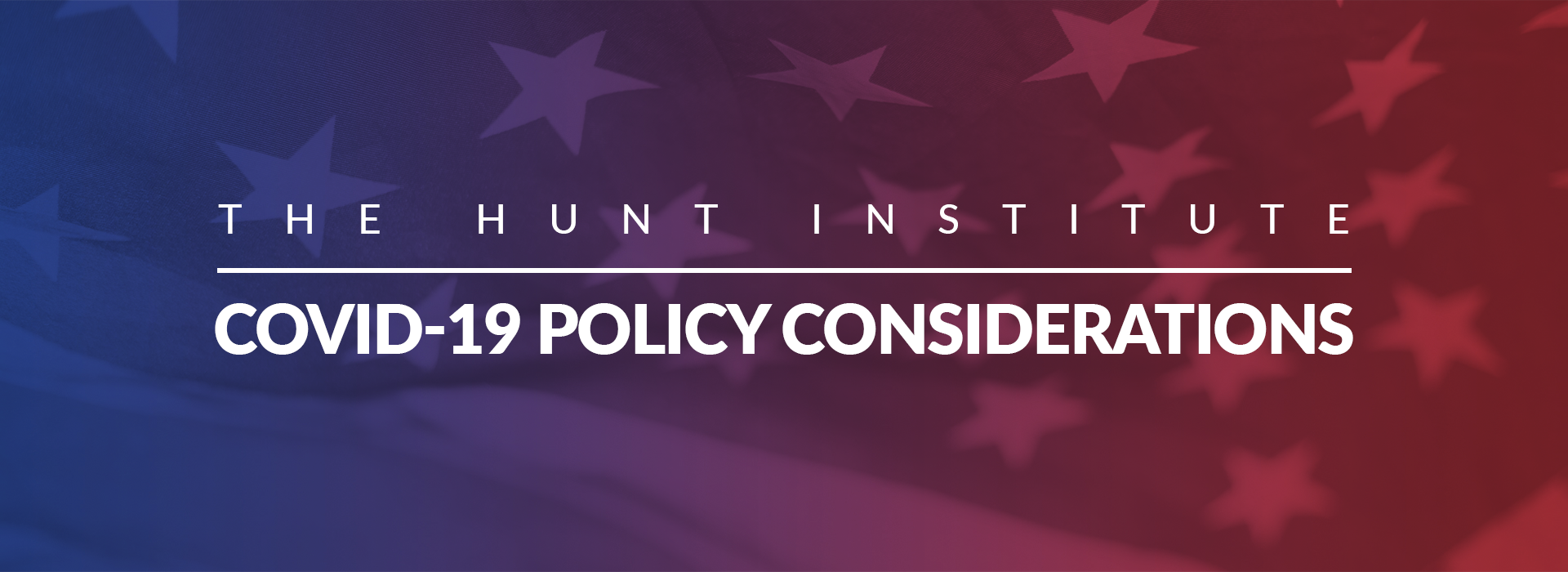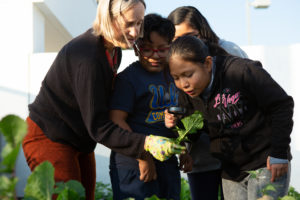

Updated: May 27, 2021
Millions of students across the country rely on school for at least one meal a day – and in some cases receive three meals a day from their school. When schools are fully remote or reopen under hybrid models of instruction, what can policymakers do to ensure children are still receiving the food they need?

Photo by Allison Shelley for EDUimages
Since the onset of the COVID-19 pandemic, the role schools played in providing food and nourishment for children and families grew significantly, as the adverse public health and economic effects of the pandemic have contributed to growing rates of food insecurity; in fact, national rates of food insecurity in households with children doubled from May-October 2020, with communities of color being most affected. To respond to this growing threat to the welfare of children and families, policymakers and leaders in the public and private sector must have a strong understanding of the food insecurity landscape so that effective and targeted relief can be provided to those families in the immediate- and long-term. Additionally, policymakers and leaders must find ways to provide relief for food insecure families as summer break approaches.
For the past year, public and private organizations have been closely tracking the COVID-19 pandemic’s impact on rates of food insecurity, on both a national and state-by-state scale. Before the COVID-19 pandemic, more than 35 million people, including nearly 11 million children, lived in a food insecure household; these numbers represented a consistent downward trend in food insecurity, yet the current crisis reversed improvements made over the past decade since the Great Recession.
In March 2021, Feeding America updated a series of projections of how rates of food insecurity in the United States would look compared to previous years, projecting overall food insecurity rates, changes in the number of people in food insecure households, the total number of people in food insecure households, and the percentage increase in the food insecurity rate. The following tables incorporate those metrics and provide both national and regional projections.
National Projections of Food Insecurity for 2020 and 2021
| Overall | 2021 (Projection) | 2020 (Projection) | 2019 (Actuals) |
| Annual Food Insecurity Rate (Overall) | 12.9% | 13.9% | 10.9% |
| Number of Food Insecure People (Overall) | 42 million | 45 million | 35.2 million |
| Ratio (Overall) | 1 in 8 | 1 in 7 | 1 in 9 |
| Annual Food Insecurity Rate (Children) | 17.9% | 19.9% | 14.6% |
| Number of Food Insecure People (Children) | 13 million | 15 million | 10.7 million |
| Ratio (Children) | 1 in 6 | 1 in 5 | 1 in 7 |
Ten States with the Highest 2021 Food Insecurity Projections Among Children
| Ranking | State | 2021 | 2020 (Ranking) | 2019 (Ranking) |
| 1 | Louisiana | 26.0% | 27.4% (1) | 23.0% (1) |
| 2 | Hawaii | 24.6% | 27.0% (2) | 19.3% (9) |
| 3 | New Mexico | 23.7% | 26.2% (4) | 22.0% (3) |
| 4 | Texas | 23.6% | 24.0% (7) | 19.6% (7) |
| 5 | Nevada | 23.0% | 26.7% (3) | 17.7% (12) |
| 6 | Arkansas | 22.9% | 24.4% (6) | 21.4% (4) |
| 7 | Oklahoma | 22.5% | 23.8% (8) | 20.4% (6) |
| 8 | Mississippi | 22.2% | 24.9% (5) | 22.2% (2) |
| 9 | Alabama | 20.4% | 23.3% (9) | 20.8% (5) |
| Arizona | 20.4% | 21.2% (16) | 17.6% (14) |
In addition to measuring food insecurity, organizations such as Feeding America are producing projections of very low food security (VLFS), which is a more severe range of food insecurity involving reduced food intake and disrupted eating patterns. 70 percent of households falling in this category of food security report seven or more of the following statements surveyed annually by the USDA:
The following table and map show the highest rates of VLFS in the country, as well as what rates of VLFS look like throughout the country.
| Ranking | State | 2021 | 2020 (Ranking) | 2019 (Ranking) |
| 1 | Oklahoma | 8.4% | 8.8% (2) | 7.6% (1) |
| 2 | Nevada | 8.1% | 9.3% (1) | 6.3% (5) |
| 3 | Hawaii | 8.1% | 8.8% (2) | 5.9% (8) |
| 4 | Louisiana | 7.8% | 8.2% (5) | 6.7% (3) |
| 5 | Maine | 7.7% | 8.4% (4) | 7.1% (2) |
| 6 | New Mexico | 7.2% | 7.9% (6) | 6.5% (4) |
| 7 | Arkansas | 6.6% | 7.0% (7) | 6.0% (6) |
| 8 | Texas | 6.5% | 6.6% (14) | 5.1% (18) |
| 9 | Arizona | 6.4% | 6.6% (14) | 5.4% (14) |
| 9 | Maryland | 6.4% | 6.6% (14) | 5.5% (12) |
Eliminating food insecurity in the United States can be done, but it will take herculean efforts and investments to accomplish that task. Currently, the food budget shortfall in the United States is over $19 billion, and while covering the cost to close this gap will be immense, federal programs are available for state and local policymakers to take advantage of. For example, the Supplemental Nutritional Assistance Program (SNAP) is a popular federal assistance program that provides temporary help for individuals in need of supplemental money to buy food until, economically speaking, those individuals can provide food adequately for themselves and their families. In 2015 alone, SNAP lifted 4.6 million Americans out of poverty, including two million children and 366,000 seniors. SNAP is a key federal program not only for providing nutritional assistance for eligible recipients; the program also has positive effects on economic activity. Economists estimate that for every dollar redeemed by a household through SNAP, about $1.70 in economic activity is generated. The estimate can be seen in previous literature confirming that for every $1 billion added to SNAP, between 8,900 and 17,000 jobs were created, and for every $1 billion cut from SNAP, over 11,000 jobs would be eliminated.
Policymakers at the state and local level must also take advantage of federal relief coming in via the American Rescue Plan (ARP). The ARP invests $12 billion in nutrition assistance, and those investments include the following actions:
Legislate methods to use local farmers to provide food in high-need areas. For example, the Senate of Virginia’s recently enacted SB1188 is a model for policymakers seeking to utilize state farmers to address food insecurity. The bill called for the establishment of the Virginia Agriculture Food Assistance Program for Virginia farmers and food producers to donate, sell, or otherwise provide agriculture products to charitable food assistance organizations.
Partner with school districts to provide meals for students over the summer. Partnerships between local food banks, school districts, and local restaurants/small businesses will be critical for serving students from food insecure households. Tracking where these partnerships are taking hold will be critical, too. Fortunately, the USDA tracks where summer meals can be found throughout the country, showing each site’s dates of operation and times when each meal will be served.
As recommended by the Harvard T.H. Chan School of Public Health, advocate for the strengthening of the federal safety net. This can be done, for example, by pushing for the expansion of SNAP benefits for families in need.
Support mobile food services. In areas of rural isolation and lack of transportation services, develop creative strategies to get food to residents, like VeggieVanGo in Vermont, to bring food directly to residents or central locations within communities.
Support collective efforts. Coalition-building among stakeholders, private businesses, and organizations with experience in combating food insecurity can be of use as policymakers and stakeholders identify the unique needs of communities in addressing the issue.
Provide more food-centered programming for older and disconnected youth. Young individuals who do not attend school or are disengaged from school-based programming are often overlooked, and policymakers should work to get a good idea of the proportion of their states’ youth populations that fall into this category. Much work has been done around engaging older youth, especially teenagers. When the Urban Institute studied efforts to address food insecurity in Vermont, the organization convened a focus group that included teenagers to discuss food-centered programming. An important takeaway from this project was how teenagers pointed out the importance of dealing with a stigma, as accepting food services, many pointed out, can be sensitive. Local youth in this group noted that teenagers may be more likely to participate in food-related programming if it was embedded in larger programs, such as recreational activities. With individuals and communities having a better sense of how to engage one another in a safe manner during the pandemic, policymakers could fund these programs for the purpose of engaging more youth.
Evidence-Based Strategies to End Childhood Food Insecurity and Hunger in Vermont (The Urban Institute)
Tracking the COVID-19 Recession’s Effects on Food, Housing, and Employment Hardships (Center on Budget and Policy Priorities)
The Impact of Coronavirus on Food Insecurity (Feeding America)
The Impact of Coronavirus on Local Food Insecurity (Feeding America)
Children’s food insecurity increasing during COVID-19 pandemic (Harvard T.H. Chan School of Public Health)
Measuring Household Experiences during the Coronavirus Pandemic (United States Census Bureau)